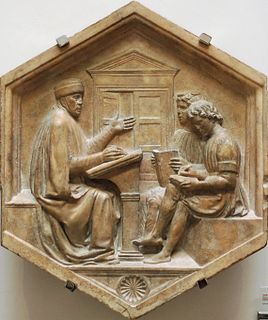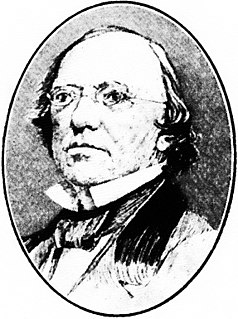
Otho was Roman emperor for three months, from 15 January to 16 April 69. He was the second emperor of the Year of the Four Emperors.

The Septuagint is the earliest extant Greek translation of the Hebrew scriptures from the original Hebrew. It is estimated that the first five books of the Old Testament, known as the Torah or Pentateuch, were translated in the mid-3rd century BCE and the remaining texts were translated in the 2nd century BCE. Considered the primary Greek translation of the Old Testament, it is quoted a number of times in the New Testament,particularly in the Pauline epistles,by the Apostolic Fathers, and later by the Greek Church Fathers.

The Vulgate is a late-4th-century Latin translation of the Bible that became the Catholic Church's officially promulgated Latin version of the Bible during the 16th century. The translation was largely the work of Jerome, who in 382 had been commissioned by Pope Damasus I to revise the Vetus Latina Gospels then in use by the Roman Church. Jerome, on his own initiative, extended this work of revision and translation to include most of the books of the Bible, and once published, the new version was widely adopted and eventually eclipsed the Vetus Latina; so that by the 13th century, it had taken over from the former version the appellation of versio vulgata or vulgata for short, and in Greek as βουλγάτα ("Voulgata").

Priscianus Caesariensis, commonly known as Priscian, was a Latin grammarian and the author of the Institutes of Grammar which was the standard textbook for the study of Latin during the Middle Ages. It also provided the raw material for the field of speculative grammar.

Cædmon is the earliest English (Northumbrian) poet whose name is known. An Anglo-Saxon who cared for the animals at the double monastery of Streonæshalch during the abbacy (657–680) of St. Hilda (614–680), he was originally ignorant of "the art of song" but learned to compose one night in the course of a dream, according to the 8th-century historian Bede. He later became a zealous monk and an accomplished and inspirational Christian poet.

Heinrich Friedrich Wilhelm Gesenius was a German orientalist, Lutheran, and Biblical critic. He is credited, among other things, with the reconstructed pronunciation of the Tetragrammaton, "Yahweh."

A vernacular, or vernacular language, is the lect used in everyday life by the common people of a specific population. It is distinguished from national, literary, liturgical or scientific idiom, or a lingua franca, used to facilitate communication across a large area. It is usually native, mostly spoken informally rather than written and usually seen as of lower status than more codified forms. It can be a distinct stylistic register, regional dialect, sociolect or an independent language.

Vetus Latina, also known as Vetus Itala, Itala ("Italian") and Old Italic, is the collective name given to the Latin translations of biblical texts that existed before the Vulgate, the Latin translation produced by Jerome in the late 4th century. The Vetus Latina translations continued to be used alongside the Vulgate, but eventually the Vulgate became the standard Latin Bible used by the Catholic Church, especially after the Council of Trent (1545–1563) affirmed the Vulgate translation as authoritative for the text of Scripture. However, the Vetus Latina texts survive in some parts of the liturgy.
In grammar, a supine is a form of verbal noun used in some languages. The term is most often used for Latin, where it is one of the four principal parts of a verb. The word is commonly used to describe a position of lying on one's back, but no one has been able to explain why it is used by grammarians to describe this part of a verb.

The Four Books of Sentences is a book of theology written by Peter Lombard in the 12th century. It is a systematic compilation of theology, written around 1150; it derives its name from the sententiae or authoritative statements on biblical passages that it gathered together.

The Nuremberg Chronicle is an illustrated biblical paraphrase and world history that follows the story of human history related in the Bible; it includes the histories of a number of important Western cities. Written in Latin by Hartmann Schedel, with a version in German, translation by Georg Alt, it appeared in 1493. It is one of the best-documented early printed books—an incunabulum—and one of the first to successfully integrate illustrations and text.

Antonio de Nebrija was the most influential Spanish humanist of his era. He wrote poetry, commented on literary works, and encouraged the study of classical languages and literature but his most important contributions were in the fields of grammar and lexicography. Nebrija was the author of the first Spanish grammar (1492) and the first dictionary of the Spanish language (1495). His grammar is also credited as the first published grammar of any Romance language. His chief works were published and republished many times during and after his life and his scholarship had a great influence for more than a century, both in Spain and in the expanding Spanish Empire.
Jonah ibn Janah or ibn Janach, also known as Abu al-Walīd Marwān ibn Janāḥ, was a Jewish rabbi, physician and Hebrew grammarian active in Al-Andalus, or Islamic Spain. Born in Córdoba, ibn Janah was mentored there by Isaac ibn Gikatilla and Isaac ibn Mar Saul, before he moved around 1012, due to the sacking of the city. He then settled in Zaragoza, where he wrote Kitab al-Mustalhaq, which expanded on the research of Judah ben David Hayyuj and led to a series of controversial exchanges with Samuel ibn Naghrillah that remained unresolved during their lifetimes.
Gustav Bickell was a German orientalist. He was born in Kassel, and died in Vienna.

Edward Robinson was an American biblical scholar. He studied in the United States and Germany, a center of biblical scholarship and exploration of the Bible as history. He translated scriptural works from classical languages, as well as German translations. His Greek and English Lexicon of the New Testament became a standard authority in the United States, and was reprinted several times in Great Britain.
The grammar–translation method is a method of teaching foreign languages derived from the classical method of teaching Greek and Latin. In grammar–translation classes, students learn grammatical rules and then apply those rules by translating sentences between the target language and the native language. Advanced students may be required to translate whole texts word-for-word. The method has two main goals: to enable students to read and translate literature written in the source language, and to further students' general intellectual development. It originated from the practice of teaching Latin; in the early 1500s, students learned Latin for communication, but after the language died out it was studied purely as an academic discipline. When teachers started teaching other foreign languages in the 19th century, they used the same translation-based approach as had been used for teaching Latin. The method has been rejected by scholars, and has no theoretical basis.

Hans Henning Ørberg was a Danish linguist and teacher. He received a master's degree in English, French and Latin at the University of Copenhagen, and taught these languages in schools in Denmark. He was the author of Lingua Latina, a widely used method for learning Latin using the natural approach.
The New Testament was written in a form of Koine Greek, which was the common language of the Eastern Mediterranean from the Conquests of Alexander the Great until the evolution of Byzantine Greek.
Otto Walper was a German theologian and philosopher.
Jewish Koine Greek, or Jewish Hellenistic Greek, is the variety of Koine Greek or "common Attic" found in a number of Alexandrian dialect texts of Hellenistic Judaism, most notably in the Septuagint translation of the Hebrew Bible and associated literature, as well as in Greek Jewish texts from Palestine. The term is largely equivalent with Greek of the Septuagint as a cultural and literary rather than a linguistic category. The minor syntax and vocabulary variations in the Koine Greek of Jewish authors are not as linguistically distinctive as the later language Yevanic, or Judeo-Greek, spoken by the Romaniotes Jews in Greece.













